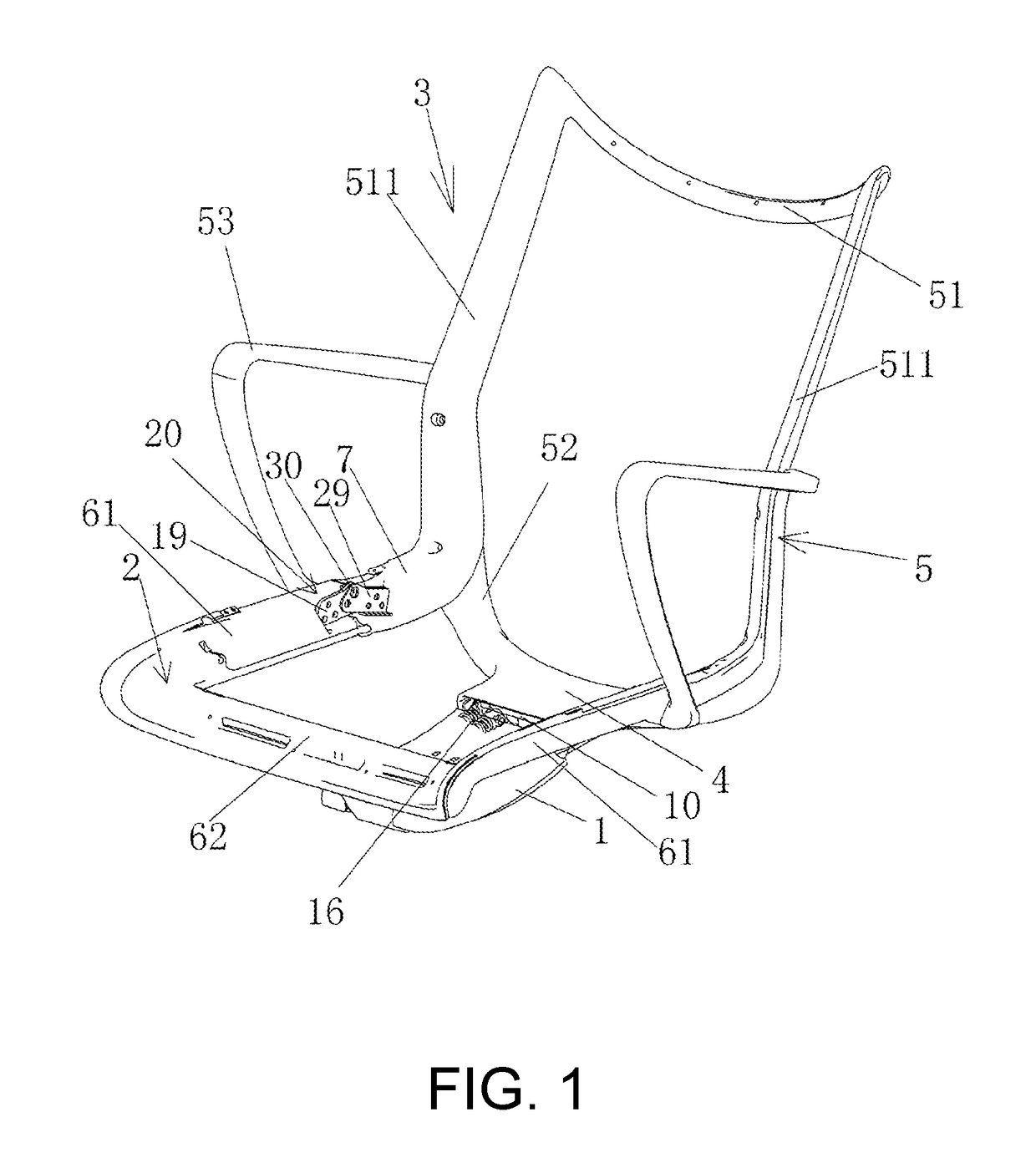Seat structure and chair
a seat and chair technology, applied in the field of chairs, can solve the problems of not being able to configure one piece of mesh fabric, not being able to meet the needs of everyone, etc., and achieve the effects of overcoming the uncomfortable feeling of users, convenient back configuration, and simple structur
- Summary
- Abstract
- Description
- Claims
- Application Information
AI Technical Summary
Benefits of technology
Problems solved by technology
Method used
Image
Examples
embodiment 1
[0064]A seat structure in the embodiment shown in FIG. 1, FIG. 2, comprising:
[0065]Base 1, configured to be the chair base assembly; metal base is preferred for base 1; the chair base assembly (not shown) includes supporting column, a plurality of supporting legs extending radially from the lower end of the supporting column and casters supporting the leg ends. Said supporting column can be an air rod.
[0066]Seat support 2. Seat support 2 is installed above base 1 and remains approximately parallel with base 1, wherein seat support 2 has rotary connection with the front end of base 1 through a transition link 8. Said seat support 2 comprises two bilaterally symmetrical supporting bars 61. The front parts of the two supporting bars 61 are connected as a whole through cross bar 62, wherein cross bar 62 has rotary connection with the front part of base 1 through transition link 8. The font end of seat support 2 is bending and extending downward and rearward into human body sitting posit...
embodiment 2
[0082]In the embodiment shown in FIG. 9, FIG. 10, FIG. 11:
[0083]A seat structure comprising:
[0084]Base 1, configured to be the chair base assembly; base 1 presents a Y shape.
[0085]Seat support 2, which is s installed above base 1; the front end of seat support 2 is bending and extending downward and rearward into human body sitting position structure, and seat support 2 has rotary connection with base 1 in a frame structure.
[0086]Switch part 22, which is located between seat support 2 and base 1, wherein both ends of switch part 22 have rotary connection with the front part of seat support 2 and the front part of base 1 respectively.
[0087]Chair back assembly 3, which has rotary connection with the rear part of base 1 through pivot 6.
[0088]Lever driving member 7, which is linked between chair back assembly 3 and seat support 2. When chair back assembly 3 turns rearward from the initial position, seat support 2 is lifted up and moved rearward by lever driving member 7; when chair back...
embodiment 3
[0100]the present embodiment is substantially the same as in embodiment 1 in terms of the relationship between the composition and the structure of the lever driving member, the chair back assembly, the seat support, the transition link and the base. The main difference between this embodiment and embodiment 1 is that, as shown in FIGS. 16-25, reset spring 71 is installed longitudinally between chair back assembly 3 and base 1, to be more specific, reset spring 71 is configured in a position closer to the front than pivot 6, which means the reset spring is completely hidden in the inner space of the base. Thus, the height space inside the base can be fully utilized, and the exterior of the seat will not be protruded by the arrangement of the reset spring, nor will it cause damage to the appearance.
[0101]The longitudinal configuration is not strictly defined as longitudinal, and does not necessarily mean that the central line of reset spring 71 coincides with the plumb line. In a bro...
PUM
 Login to View More
Login to View More Abstract
Description
Claims
Application Information
 Login to View More
Login to View More - R&D
- Intellectual Property
- Life Sciences
- Materials
- Tech Scout
- Unparalleled Data Quality
- Higher Quality Content
- 60% Fewer Hallucinations
Browse by: Latest US Patents, China's latest patents, Technical Efficacy Thesaurus, Application Domain, Technology Topic, Popular Technical Reports.
© 2025 PatSnap. All rights reserved.Legal|Privacy policy|Modern Slavery Act Transparency Statement|Sitemap|About US| Contact US: help@patsnap.com



